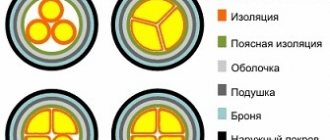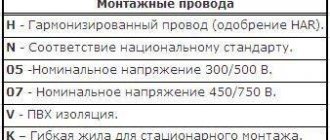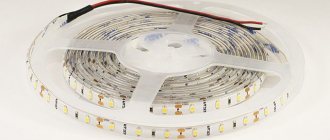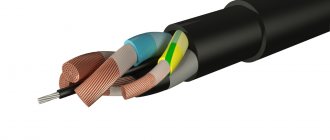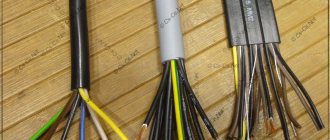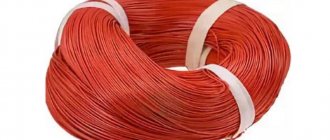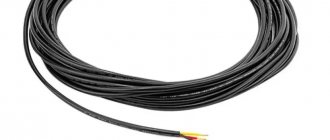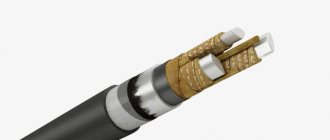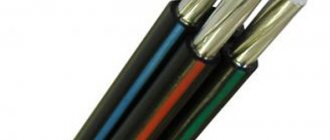What is a conductor?
A conductor is a substance or material that perfectly conducts electric current.
As you all know, any substance consists of atoms. Atoms, in turn, consist of electrons and nuclei. (More details about the structure of the atom).
Let's look at this picture for understanding. Let's assume that the shepherd is the nucleus and the sheep around him are the electrons.
Those sheep that are next to the shepherd cannot just run away from him, since he is looking after them. Otherwise, he will be left without meat and wool by autumn. But those sheep that are at a distance from the shepherd have every chance of running away from him.
The same can be said about atoms and electrons. Electrons that are in the farthest orbit from the nucleus are less dependent than those that are located closer to the nucleus.
As a result, such electrons can “break away” from the nucleus and begin an independent journey through the substance. Such electrons are called free electrons .
The more free electrons, the better the conductivity of the substance.
Construction lengths of cable and wire products
Construction lengths of power cables
Power cables with impregnated paper insulation
| Voltage, kV | Section, mm | Construction lengths, m (not less than the quantity of the length of the delivery lot excluding small lengths), %, not less | Small segments | ||
| 70 % | 30 % | Amount of length, %, no more | Length, m, not less | ||
| 1 and 3 | up to 70 | 300 | 450 | 10 | 50 |
| 1 and 3 | 95 and 120 | 250 | 400 | 10 | 50 |
| 1 and 3 | 150 or more | 200 | 350 | 10 | 50 |
| 6 and 10 | up to 70 | 300 | 450 | 5 | 100 |
| 6 and 10 | 95 and 120 | 250 | 400 | 5 | 50 |
| 6 and 10 | 150 or more | 200 | 350 | 5 | 50 |
| 20 and 35 | all sections | 250 | 250 | 5 | 100 |
Power cables with plastic insulation
| Voltage, kV | Section, mm | Construction length, m | Note |
| Up to 3 inclusive | 1.5-16 | 150 | No more than 20% of cables with a length of at least 50 m are allowed in a batch |
| 25-70 | 300 | No more than 10% of cables with a length of at least 50 m are allowed in a batch | |
| 95 and above | 200 | ||
| 6 | 10-70 | 450 | No more than 20% of cables with a length of at least 50 m are allowed in a batch |
| 95 and above | 400 |
Flexible general purpose power cables with rubber insulation
| Stamps | Construction length, m | Small segments | |
| section length, m | allowable supply, % | ||
| KG, KGN, KPGU | not less than 125 | at least 20 | no more than 20 |
| PRS | not less than 100 | at least 10 | no more than 10 |
Construction lengths of control cables
Control cables with PVC insulation in PVC sheath as a percentage of the lot
| Stamps | Length, m | % |
| KUGVV | 100 or more, no less | 80 |
| 3-100, no more | 20 | |
| KUGVEV | 100 or more, no less | 50 |
| 3-100, no more | 30 | |
| 10-30, no more | 20 | |
| KUGVVE | 100 or more, no less | 70 |
| 3-100, no more | 20 | |
| 10-30, no more | 10 |
Control cables with PVC insulation KUPV, KUPV-P, KUPV-Pm and KUPV-Pn
| Cable | Length, m | Quantity of the total length of the batch, % |
| With unshielded cores | more than 201 | not less than 70 |
| 21-200 | no more than 30 | |
| With shielded and partially shielded conductors | more than 201 | at least 50 |
| 10-200 | no more than 50 |
Control cables with PE insulation and rubber sheath KUPR, KUPR-P, KUPR-Pn, KUPR-Pm
| Stamps | Number of cores | Construction length, m | Number of small lengths of the total length of the batch, % |
| With unshielded cores | up to 37 | more than 101 | at least 30 |
| 51-100 | at least 30 | ||
| 21-50 | no more than 40 | ||
| up to 61 | more than 161 | at least 25 | |
| 121-160 | at least 20 | ||
| 61-120 | at least 35 | ||
| With fully and partially shielded cores | 31-60 | no more than 20 | |
| more than 44 | not less than 80 | ||
| 21-43 | no more than 20 | ||
| more than 61 | not less than 70 | ||
| 10-60 | no more than 30 |
PVC control cables
| Stamps | Construction length, m | Small segments | |
| Length not less than m | Quantity of the total length of the delivered lot, %, no more | ||
| KGVV | not less than 100 | 10 | 20 |
Control cables for fixed installation with PE insulation
| Stamps | Construction length, m | Number of small lengths in the total cable length in % |
| KPV, KPVB without shielded cores | 201 or more | at least 40 |
| 101 – 200 | no more than 40 | |
| 35 – 100 | no more than 20 | |
| KPV, KPVB with shielded conductors | 201 or more | no more than 20 |
| 101 – 200 | no more than 40 | |
| 35 – 100 | no more than 30 |
Cables, wires and cords with PVC insulation
| Stamps | Minimum construction length, m |
| MKS | 60 |
| MKESH | 25 |
| NV, NVM | 500 |
| NV, NVME | 20 |
| ШСМРВ | 30 |
| SHVVM | 50 |
| KMPV | 50 |
Wires with combined fiber-PVC insulation
| Stamps | Minimum construction length, m |
| MSHV, MGSHV, MGSHVE | 50 |
Wires with PE insulation
| Stamps | Minimum construction length, m |
| NP | 50 |
| NPE | 20 |
| MS, ITU 32-11 | 25 |
| RMPVN | 20 |
| PVMP-2 (2.5;4) | 10 |
Construction lengths of installation cables and wires
Irradiated polyethylene insulated wires
| Stamps | Minimum construction length, m |
| MPO, MPOE | 50 |
| MGDPO | 30 |
| MLP, MLPE | 30 |
| MLTPE, MLTPE | 50 |
| MSTTP, MSTPE, MSTPL | 50 |
Wires with fluoroplastic insulation
| Stamps | Minimum construction length, m |
| MPO 33-11, MPOE 33-11 | 25 |
| PMOF | 25 |
Flat ribbon wires
| Stamps | Minimum construction length, m |
| PLVV | 20 |
| LSV, LSP | 7 |
| LPPV, LPPV | 20 |
| PLVV | 20 |
Thermocouple and thermoelectrode wires
| Stamps | Minimum construction length, m |
| PTV, PTVP, PTGV | 100, 50 and 10 m in quantities of 65, 25 and 10%, respectively. with batch length |
Construction lengths of control and signal-blocking cables
Control cables
| Construction length, m | Small segments | |
| section length, m | permissible supply in % | |
| not less than 150 | at least 20 | no more than 15 |
| not less than 150 | 20-50 | no more than 5 |
Signal blocking cables
| Construction length, m | Small segments | |
| section length, m | permissible supply in % | |
| not less than 300 | at least 50 | |
Construction lengths of special purpose cables
Marine cables with plastic insulation and sheath
| Stamps | Construction length, m | Small segments | |
| length, m, not less | Quantity of the total length of the delivered lot, %, no more | ||
| KMPV, KMPVE | 200 | 30 | 23 |
| KMPVEV | 200 | 10 | 7 |
| KMVVE | 125 | 30 | 23 |
| KMPEV | 125 | 70 | 25 |
| KMPEVE | 125 | 30 | 18 |
| KMPEVEV | 125 | 10 | 7 |
Cables for mining and earthmoving
| Stamps | Construction length, m | Small segments | |
| section length, m | permissible delivery within the lot, % | ||
| KGE, KGESH, etc. | not less than 200 | no more than 50 | no more than 10 |
Marine cables with rubber insulation
| Stamps | Construction length, m | Small segments | |
| length, m, not less | Quantity of the total length of the delivered lot, %, no more | ||
| China, China, China, China, China | not less than 125 | 25 | 10 |
Cables for oil fields
| Stamps | Construction length, m with permissible maximum deviation from construction lengths, % ± 3 |
| KPBK 3x6 | 1100 |
| KPBK 3x10 | 1100, 1250, 1400, 1500, 1800 |
| KPBK 3x16 | 1100, 1250, 1400, 1500, 1800 |
| KPBK 3x25 | 1000, 1350 |
| KPBK 3x35 | 900 |
| KPBK 3x50 | 500 |
| KPBP 3x6 | not less than 300 |
| KPBP 3x10 | 1100, 1250, 1400, 1500, 1800 |
| KPBP 3x16 | 1100, 1250, 1400, 1500, 1800 |
| KPBP 3x25 | 1100, 1350 |
| KPBP 3x35 | 900 |
| KPBP 3x50 | 500 |
Construction lengths of cables and communication wires.
Telephone communication cables with PE insulation
| Stamps | Nominal number of pairs | Length, m not less |
| TPPEP, TPV, TPPEPZ | 10 – 20 20 – 50 50 – 150 150 -300 300 – 600 600 – 1200 1200 – 2400 | 500 400 300 250 200 150 125 |
Telephone communication cables with air-paper and porous-paper insulation
| Stamps | Nominal number of pairs | Length, m not less |
| TG, TB, TBG | 10 – 20 30 – 50 100 – 200 300 – 400 500 – 1200 1400 – 1600 | 500 300 250 200 150 125 |
Wires and communication cords
| Stamps | Construction length, m, not less |
| ATSNV, ATSRV, ATSShv | 50 |
| ATSKV | 100 |
| ATSDIV, ATSSHV | 30 |
| PKSV | 100 |
| SHT, SHTEM, SHTE | supplied in spiral sections 3000 m long with ends 120 and 260 mm long |
| SHTLEE, SHTLIE | supplied in lengths of 2300 mm with bare ends in lengths of 120 and 100 mm |
| ShSV, ShSMV | 20 |
| SHTGELM, SHPEV | 50 |
| ShKV, ShKVO | 22 |
Construction lengths of wires for electrical installations
Wires with rubber insulation
| Stamps | Construction length, m | ||
| normal | small sizes | % to batch | |
| PRGI, PRGN | 100 | 20 | 10 |
| PRTO, APRTO, APRI | 100 | 20 | 10 |
| APRF, PRF, PRFl | 50 | 15 | 10 |
| APRN | 100 | 20 | 10 |
| PRP, PRRP | 50 | 15 | 10 |
| PRD, PRVD | 100 | 20 | 10 |
| PRG-6000 | 50 | 3 | 20 |
| ART | 110 | 25 | 10 |
Wires with plastic insulation
| Stamps | Construction length, m | ||
| normal | small sizes | % to batch | |
| AVT, AVTU, AVTV | 110 | 25 | 10 |
| AMPPV, AMPPV | 100 | 20 | 20 |
| APV, APPV | 100 | 20 | 20 |
| ERW, runway | 70-600 | 7 | 7 |
| PV-1 | 100 | 20 | 10 |
| PV-2 | 100 | 20 | 10 |
| PV-3 | 100 | 20 | 10 |
| PV-4 | 100 | 5 | 10 |
| PV-L | 50 | 10 | 20 |
| ERW | 100 | 20 | 10 |
| PSVL | 15 | 8 | 25 |
| PSVLU | 100 | 25 | 30 |
| SPP | 1zh-200-1300 | 200 | 5 |
| SPP | 2zh-520±20 | 200 | 5 |
Wires with heat-resistant insulation
| Stamps | Construction length, m | ||
| normal | small sizes | % to batch | |
| PAL, PALO, PSALM | 10 | 1,5 | 15 |
| PSU-155 | 15 | by agreement | by agreement |
| PSU-180 | 15 | 5 | 10 |
Conductor resistance
Resistivity
And now we smoothly move on to another question: what is conductor resistance ? As I said above, the more free electrons in a substance, the better the substance conducts electric current. Therefore, the resistance of a conductor depends on how many free electrons such a conductor contains. Therefore, in physics there is such a concept as specific resistance of a substance .
Find out what a proton is right now.
Again. If a substance is full of free electrons, then such a substance will conduct electricity well. If there are even fewer electrons, then such a substance will poorly conduct electric current. And if there are almost no free electrons, then such a substance will not conduct current at all. Therefore, the resistivity of a substance shows the ability of that substance to resist electric current passing through it.
Resistivity is expressed in units of Ohm x m.
Conductor resistivity formula
Where
ρ is the resistivity, Ohm × m
R - conductor resistance, Ohm
S—cross-sectional area, m2
l—conductor length, m
The cross-sectional area of a conductor is something like this:
conductor cross-sectional area
Conductor resistance formula
So, we now know such a physical quantity as resistivity. Now we can easily find the resistance of the conductor.
Where
ρ is the resistivity, Ohm × m
R - conductor resistance, Ohm
S—cross-sectional area, m2
l—conductor length, m
Section calculation
So, first of all, it is necessary to sum up the power of all household appliances. It's very simple, you can even do it in your head. For example, the result will be 7.5 kW. By the way, this is the average load in most city apartments. Just twenty years ago this figure did not exceed 5 kW. It's all about the increase in the number of household appliances we use. Now we move on to implementing the choice of electrical wire material. Comparing the table, we can conclude that in the case of a copper cable the cross-sectional value will be equal to 4 mm², and with aluminum – 6 mm². At the same time, copper with a cross-section of 4 mm² can withstand a load of up to 8.3 kW, aluminum up to 7.9 kW. That is, a certain safety margin has already been built in, which increases the reliability of the electrical wiring.
Attention! Regardless of the fact that the power reserve has already been determined, it is recommended to take a slightly larger cable cross-section (up to the next indicator). This is done for the future, because there is a high probability that new household appliances will appear in the house, which will increase the total load on the network.
Now, regarding the three-phase network. In many private houses, three phases are supplied, and in some city apartments they are also present. Basically, what is a three-phase network? These are three phases and zero. That is, it turns out that three single-phase networks enter the house. All calculations related to power and wire cross-section are carried out in exactly the same way as with a single-phase network. True, there is one strict requirement - the total load must be distributed evenly among the phases. The same example, where the power consumption of the house is 7.5 kW. So this indicator in each phase should be 2.5 kW.
What does this mean? Remember our example, where the cable cross-section for a single-phase network was calculated at a load of 7.5 kW. It was determined that the best option for this is copper wire with a cross-section of 4 mm². Since the total load of the network is divided into three phases, each of them requires a wire with a cross-section corresponding to a power of 2.5 kW. And this is 1.5 mm².
Conductors on printed circuit boards
As you know, all circuits consist of wires or printed tracks that connect various radio elements into a single whole. For example, in the article “The simplest sound amplifier,” I connected various radio elements using wires, and I got a circuit that amplified sound frequencies.
In order for everything to be beautiful, aesthetically pleasing and take up little space, “wiring” is created directly on the boards, which are already called “printed tracks”.
At home, all this is done using LUT technology (Laser-Ironing-Technology).
On the other side of the printed circuit board there are already radio elements
Since radio amateurs try to make their devices as small in size as possible, the installation density increases. Therefore, in some cases, radio elements and printed tracks are located on both sides of the board.
Industrial printed circuit boards are already made multilayer. They consist of layers, like a cake made of layers:
The boom in SMD technology has in turn created a need for multilayer printed circuit boards.
Superconductivity
Also in nature there is such an effect as superconductivity . Superconductivity is when some materials and their alloys have no resistance at all. That is, their resistance is very, very close to zero. But, I hasten to disappoint you, this is impossible to achieve under simple conditions, since this is achieved only at critical temperatures.
If you want to learn more about materials that are used in electronics and electrical engineering, download this book.
I recommend reading - Electric current power.
Parameters for performing calculations
Remember one point - the electrical network of the house is divided into sections (loops), in which it is necessary to carry out calculations separately. Plus calculate the cross-section of the common wire leading to the house. The thing is that the number of household appliances and light sources in different rooms will differ. For example, there will be more of them in the kitchen; in the hallway there is nothing at all except lighting. In addition, the modern approach to electrical wiring requires dividing areas in rooms into two groups: lighting and sockets. That is, each group will have its own separate wire.
Let's look at how to correctly calculate the cable cross-section for power in one room where several household appliances are used. So, input data.
- Maximum total load of all consumers. As mentioned above, these indicators can be found in the product passport or on the tags of the device itself. If neither one nor the other is left, then the only way for you is the Internet. Today there are many sites on the Internet that offer tables with the power parameters of each household appliance. So this is not a problem today.
- Mains voltage. This is either 220 volts or 380 volts.
- The material from which the electrical wire is made. In principle, the variety here is small, only two positions: copper or aluminum. We will not go into details; there is also a table of the ratio of cable cross-section and material on the Internet. The only thing we note is that with the same power consumption, you can install a copper cable with a smaller cross-section compared to aluminum.
